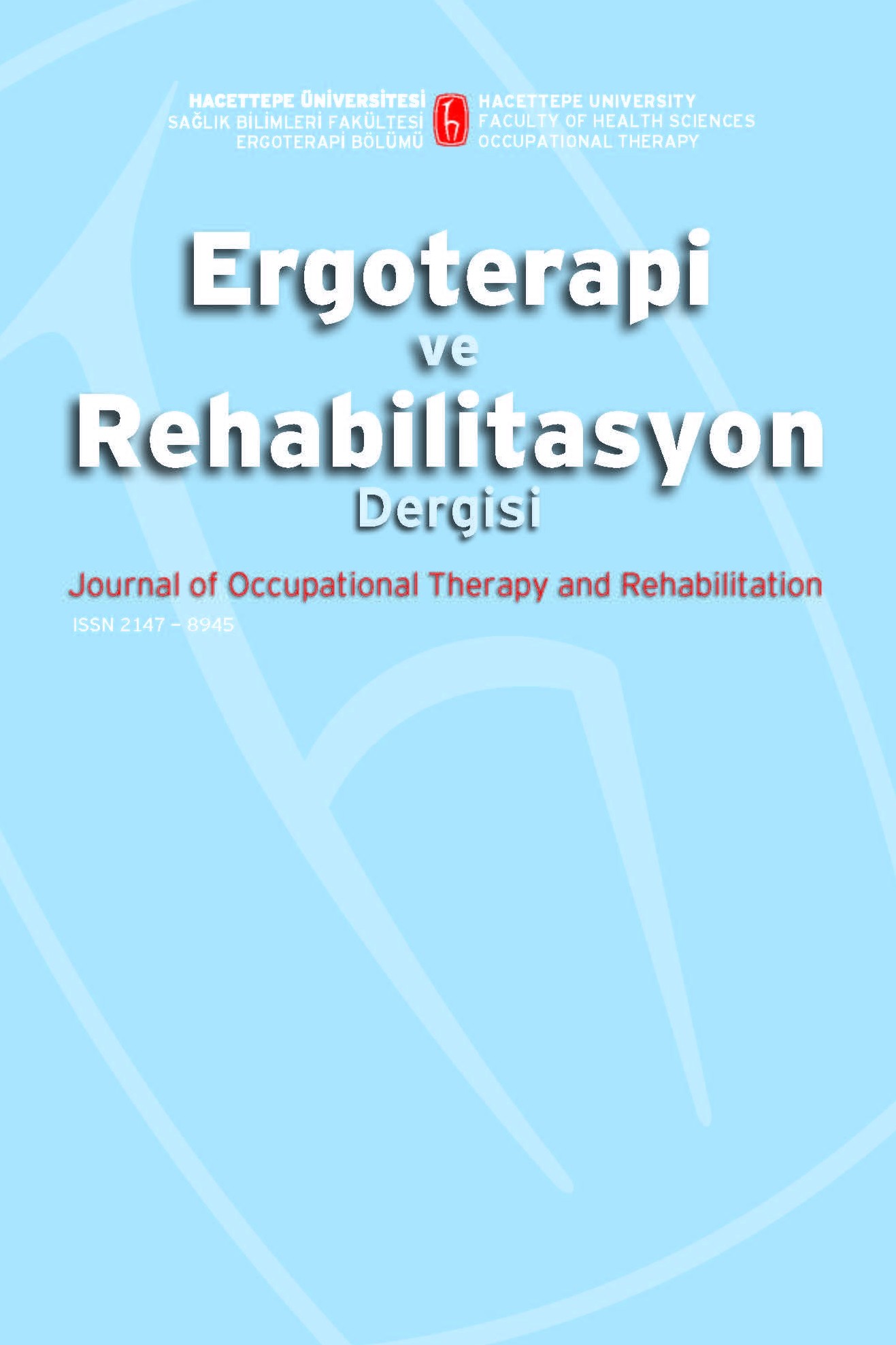Goalball Sporcularında Ayakkabının ve Görmenin Denge Üzerine Etkisinin İncelenmesi
Sporlar, Görme-düşük, Denge, Ayakkabılar
Evaluation of the Effect of Shoes and Seeing on Balance in Goalball Players
Sports, Vision-low, Balance, Shoes,
___
- Anand, V., Buckley, F. G, Scally, A., & Elliott, D. B. (2003). Postural stability in the elderly during sensory pertubations and dual tasking: the influence of refractive blur. Invest Ophthalmol Vis Sci, 44, 2885-9.
- Aydoğ, E., Aydoğ, S. T., Cakci, A., & Doral, M. N. (2006). Dynamic postural stability in blind athletes using the biodex stability system. Int J Sports Med, 27(5), 415-8.
- Brenton-Rule, A., Bassett, S., Walsh, A., & Rome, K. (2011). The evaluation of walking foot wear on postural stability in healthy older adults: an exploratory study. Clin Biomech (Bristol, Avon), 26, 885-887.
- Choy, N. L., Brauer, S., & Nitz, J. (2003). Changes in postural stability in women aged 20 to 80 years. J Gerontol A Biol Sci Med Sci, 58, 525–530.
- Çalışkan, E., Pehlivan, A., İnal, S., Dane, Ş., & Akar, S. (2006). Goalball sporunun ve hareket eğitiminin görme engelli çocukların fiziksel uygunluk üzerine etkilerinin değerlendirilmesi. Journal of Physical Education and Sport Sciences, 8(3), 3-14.
- Foster, E. C., Sveistrup, H., & Woollacott, M. H. (1996). Transitions in visual proprioception: a cross-sectional developmental study of the effect of visual flow on postural control. J Mot Behav, 28, 101–112.
- Friedrich, M., Grein, H. J., Wicher, C., Schuetze, J., Mueller, A., & Lauenroth, A. (2008). Influence of pathologic and simulated visual dysfunctions on the postural system. Exp Brain Res, 86(2), 305–14.
- Güçhan, Z., Özaydınlı, E. I., Demirel, S., Yüzlü, V., & Bek, N. (2014). Ayakkabı kullanımı ile ayak deformiteleri, denge ve fonksiyonel performans arasındaki ilişkinin incelenmesi. Journal of Exercise Therapy and Rehabilitation, 1(1), 35-42.
- Hsu, W. L., Scholz, J. P., Schoner, G., Jeka, J. J., & Kiemel, T. (2007) Control and estimation of posture during quiet stance depends on multi joint coordination. J Neurophysiol, 97(4), 3024–35.
- http://international.chattgroup.com/sites/default/files/user_gui de_huber_360_-_1786.pdf (Ulaşılabilir link), Erişim tarihi: 30.04.2016
- Klavina, A., & Jekabsone, I. (2014). Static balance of persons with intellectual disabilities, visual impairment and without disabilities. European Journal of Adapted Physical Activity, 7(1), 50-57.
- Krishnamoorthy, V., Yang, J. F., & Scholz, J. P. (2005). Joint coordination during quiet stance: effects of vision. Exp Brain Res,164(1), 1–17.
- Lieberman, L. J., & McHugh, B. E. (2001). Health re1ated fitness of children with visual impairments and blindness. J Vis Impair Blind, 95(5), 272-286.
- Menant, J. C., Steele, J. R., Menz, H. B., Munro, B. J., & Lord, S. R. (2009). Effects of walking surfaces and foot wear on temporospatial gait parameters in young and older people. Gait Posture, 29, 392-397.
- Nakata, H., & Yabe, K. (2001). Automatic postural response systems in individuals with congenital total blindness. Gait Posture, 14, 36–43.
- Nashner, L. M. (1993). Practical biomechanics and physiology of balance. In G.P. Jacobson, C.W. Newman & J. M. Kartush (Eds), Handbook of balance function testing (pp. 261-79). St. Louis: Mosby Yearbooks.
- O'Connell, M. (2000). The effect of brailling and physical guidance on the self efficacy of children who are bIind (Unpublished master'sthesis). State University of New York College at Brockport, NY.
- Portforts-Yeomans, C. V., & Riach, C. L. (1995). Frequency characteristics of postural control of children with and without visual impairment. Dev Med Child Neurol, 37,456–463.
- Riskowski, J., Dufour, A. B., & Hannan, M. T. (2011). Arthritis, foot pain and shoe wear: Current musculoskeletal research on feet. Curr Opin Rheumatol, 23,148-155.
- Sasaki, O., Usami, S., Gagey, P.M., Martinerie, J., VanQuyen, M., & Arranz, P. (2002). Role of visual input in nonlinear postural control system. Exp Brain Res, 147,1– 7.
- Simeonov, P., Hsiao, H., Powers, J., Ammons, D., Amendola, A., Kau, T. Y.,& et al. (2008). Foot wear effects on walking balance at elevation. Ergonomics, 51, 1885-1905.
- Sümbüloğlu, K., & Sümbüloğlu, V. (1994). Biyoistatistik. Ankara: Özdemir Yayıncılık.
- Tomomitsu, M. S., Alonso, A. C., Morimoto, E., Bobbio, T. G., & Greve, J. (2013). Static and dynamic postural control in low-vision and normal-vision adults. Clinics, 68(4), 517- 521
- Whitney, S. L., & Wrisley, D. M. (2004). The influence of foot wear on timed balance scores of the modified clinical test of sensory interaction and balance. Arch Phys Med Rehabil, 85, 439- 443.
- ISSN: 2147-8945
- Yayın Aralığı: Yılda 3 Sayı
- Başlangıç: 2013
- Yayıncı: Hacettepe Üniversitesi Sağlık Bilimleri Fakültesi
Goalball Sporcularında Ayakkabının ve Görmenin Denge Üzerine Etkisinin İncelenmesi
Bihter AKINOĞLU, Tuğba KOCAHAN, Tuğba BİRBRN, Necmiye ÜN YILDIRIM, Adnan HASANOĞLU, Gülcan KARAMAN
Rehabilitasyon Çalışanlarının Aile İşlevselliğine Yönelik Görüşleri Üzerine Nitel Bir Çalışma
Bant ile Gerdirme Yönteminde Pul Kullanmanın Erken Dönem İşlevsel ve Cerrahi Sonuçlara Etkileri
Visual Perception Skills Among Children of Different Socioeconomic Status
Hatice ABAOĞLU, Babak KASHEFIMEHR, Gülfer KATIRCIBAŞI, Esra AKI
Okulöncesi Otizm Spektrum Bozukluğu Olan Çocuklarda Duyu-Motor-Biliş Fonksiyonları
Mustafa ULUYOL, Mehmet YANARDAĞ
Rüya Gül DURMAZ, Gökçen AKYÜREK, Gonca BUMİN
Üniversite Öğrencilerinde Zaman Yönetimi Becerileri ile İyilik Hali Arasındaki İlişkinin İncelenmesi
Fulya Damla ÇOLAK, Gökçen Akyürek, Hatice Abaoğlu, Gonca Bumin
